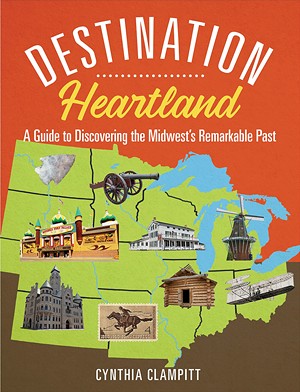
As the weather turns chilly and the leaves start turning, there is still time to get in one or two last outings before cold weather hits. Cynthia Clampitt's book Destination Heartland – A Guide to Discovering the Midwest's Remarkable Past offers ideas. Destinations include historic towns and inns, museums and living-history venues, forts and lighthouses, sites devoted to ethnicity and ancestry, plus many more. Places to visit close to home, in Illinois, or in another Midwest state are recommended in the book.
In the introduction, Clampitt shares why she wrote the book: "To encourage readers to seek out the many delightful places where one can visit Midwestern history...from simply viewing to exploring and engaging." She acknowledges that the list of sites is not comprehensive but focuses on ones that have significance to Midwest history.
In the first chapter, "Creating and Defining the Midwest," Clampitt writes about the Midwest's development after the ice age, during the era of trappers, traders, pioneers and settlers, and changes through time.
Sites in 12 states are included in order of statehood. The reader can travel through Ohio, Indiana, Illinois, Missouri, Michigan, Iowa, Wisconsin, Minnesota, Kansas, Nebraska, North Dakota and South Dakota. In each chapter destinations are listed in this order. Each destination includes the history of the site and its significance. The information helps to choose a site to visit, and provides a guide when one actually makes a visit.
The book can be used to determine a trip in several ways. Looking for places to stop in a particular state? Choose from the destinations listed under each state. Looking for something close to home? Then turn to the list of Illinois sites. Clampitt has included Springfield's various Lincoln sites, New Salem, the African American History Museum, the Dana-Thomas House, the Illinois State Museum and Elijah Iles House.
Another way to use the book is to turn to the table of contents and find sites that fit a certain type of destination. In one chapter, "Eating and Sleeping History," options include historic inns and dining venues such as the Rathseller (Indianapolis), DeSoto House (Galena), The Village Tavern (Long Grove, Illinois), plus many others.
Maybe a trip to a reenactment or show offers an ideal getaway. In "Experiencing History," Clampitt includes such places as the Garfield Farm Museum in Campton Hills, Illinois, and The Feast of the Hunter's Moon October festival in West Lafayette, Indiana.
Chapters focus on a particular look at history. "Witnessing History" lists living history sites and museums with interpreters and hands-on activities – maybe to Sauder Village Living History Museum and Farm in Archbold, Ohio, Conner Prairie in Fishers, Indiana, the Naper Settlement in Naperville, Illinois, or farther away to Old Cowtown Museum in Wichita, Kansas, with a trapper's cabin, old Western-style street complete with wooden sidewalks and shops.
"Perusing History," one of the longest chapters, includes vintage sites, historic homes and large and small museums that offer tours or self-guided walks. Choices that might be of interest are the Johnny Appleseed Museum in Urbana, Ohio, the History Center in Fort Wayne, Indiana, the Chinese American Museum in Chicago, Brucemore, a Queen Anne-style mansion, and the National Czech and Slovak Museum and Library, both in Cedar Rapids, Iowa.
The J.H. Hawes Grain Elevator Museum in Atlanta, Illinois, includes a fully restored wooden grain elevator with a train car next to it. The John Deere Pavilion in Moline, Illinois, displays farming implements used in the 1800s.
"Exploring History" focuses on historic towns. Quite a few of the destinations included are in Illinois, such as Bishop Hill, settled by Swedish immigrants in the 1840s, Cahokia Mounds, a UNESCO World Heritage site near Collinsville, The Grove, a 145-acre preserve with interpretive center in Glenview, Illinois, and the Illinois Railway Museum in Union, Illinois. Farther away are Windmill Island in Holland, Michigan, known for windmills and tulips, the Amana Colonies in Iowa, and Fort Snelling in St. Paul, Minnesota, which overlooks the junction of the Mississippi and Minnesota Rivers.
Clampitt calls her book, "my love letter to the Midwest and its history." For one looking for a fun and historic place to visit, Clampitt's book is chockful of ideas and offers an easy way to explore possibilities. What might be difficult is choosing where to go first.
Cinda Ackerman Klickna had never heard of the some of the sites listed in the book. She now has a new bucket list.

